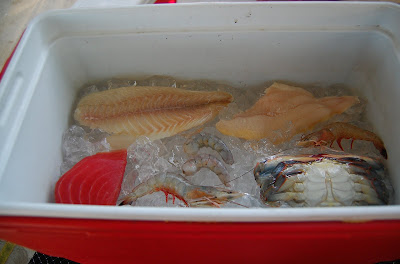It’s probably too late for you to befriend this lonely little peach, but if there are any like it at your local farmers’ market, consider this. Once a year, when the straggler peaches—likely the ones stunted in an early frost or just unloved by the elements—hang late on the trees, lovers of the rare and strange can savor a delicacy.
I stumbled upon it last year, when we had baskets of tiny September peaches littering our kitchen, and I was running out of energy, time and ideas. I rifled through my cookbooks and came upon a few recipes for roasted peaches and other stone fruits. One in an Alice Waters cookbook suggested lots of lemon juice and honey, another (can’t remember which now) advised butter, lemon zest and thyme, no added liquids.
I took a long look at these little guys—most of them were starting to get wrinkly, but very few were succumbing to that nasty moldy rot that infests overripe peaches. In fact, they looked kind of unsexy, since they weren’t juicy or lush, but at the same time wholesome and attractive. (I’m searching for some analogy to an experienced and weathered middle-aged person, but letting it drop since a little close to home.)
For reasons that probably had more to do with what was available in my pantry than some innate culinary wisdom, I opted to merge recipes and go for the utmost simplicity. I halved as many peaches as would fit in a baking dish and drizzled them with a mixture of honey, thyme, lemon juice, zest and a pinch of salt. I scattered a few more thyme sprigs about, put them in a 400° oven, and after about 20 minutes, basted them every 10 minutes or so. When the tip of my knife slid into a piece and they looked crinkly, I took them out.
The flesh was transformed into a silky, dense, almost custardy substance. I’ve tried this with midseason fruit and it just doesn’t work—it turns into something else delicious, but more like a compote. But when I tried it again last week, it worked like a charm. Because these fruits are a bit dry and their sugar is underdeveloped, they desiccate into something exotic, like a fresh-dried apricot. The honey and thyme make the experience of eating them—especially if you do so with Greek yogurt and some more honey—feel positively Attic.
On another note, I posted last time about this amazing catfish I bought from Muddy Waters at the MFM. Here are some photos of these guys—I took them right after buying some deelish redfish that I cooked up into a garlicky chowder. The pink color is from tomato paste, and I finished it with some corn kernels and fresh basil.
Muddy’s fish is great, and don’t these guys have lovely smiles?
Subscribe Now
Subscribe to:
Post Comments (Atom)











Liz! I never really understood that this was your blog, I thought it was something that you wrote for occassionally and/or referenced. How I missed this, I don't know. I've read up to this point, procrastinating a big assignment this afternoon, and I am so excited to try some of your recipes and suggestions. I've never braised anything or rubbed berbere on meat but I can't wait to start trying. Thanks for the entertainment and inspiriation! Solly looks so big and so great. Haven't caught a picture of Gus on here yet, but I'll be back. I hope everyone is doing well.
ReplyDelete-Katy Sullivan